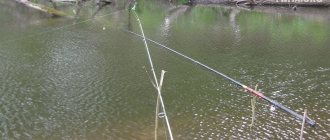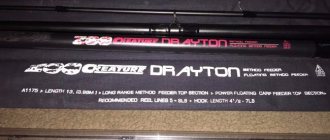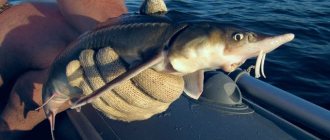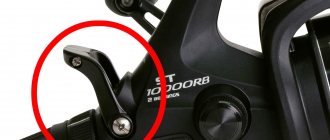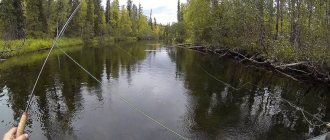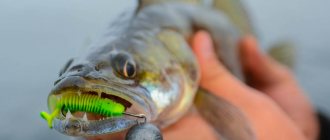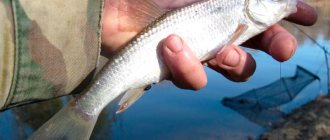Just look on the Internet to read hundreds of reviews about fishing on Seliger on local forums. And it was noted that most of them confidently confirm the information from trophies and the abundance of fishing spots.
On Seliger you can try any sports gear and each (without a doubt!) will prove itself to one degree or another, but it will definitely not leave you without a catch. In addition to the main lakes, it is worth paying serious attention to reaches and creeks. After all, it is in these watery “nooks and crannies” that gray-haired lake “monsters” can hide...
What kind of fish can you catch on Seliger?
If you are a fan of spinning, then do not pass by pike fishing spots on Seliger. Believe me, the toothy predators here are not some kind of “pencils” and “screwnuts”, but truly seasoned representatives of their species.
Connoisseurs of bream fishing will not be able to sit quietly with a fishing rod, because in addition to ordinary bream fishermen, there is a great chance of hooking a real “silver spade” - bream, which will decorate any table or photo report.
Whatever you say, fishing on Seliger in the summer is not complete without catching zealous “sailors”. Perches dart almost everywhere, sometimes even swimming into beach areas, chasing fry. But if you want to catch a respectable “humpback whale”, then you should go for deep overgrown holes and edges.
The carp here are capricious and cautious. But if you take the time and taste preferences of the local “fatties”, your list of trophies will probably be replenished with a new entry.
There is no need to talk about minnows, roaches, bleak and other white “trifles”. Catch it - I don’t want to. But not everyone can catch a catfish. But on Seliger you will have the opportunity to test the “grandfather’s” quok, and even personally get to know the mustachioed giant of the local waters.
Where to find fishing spots on Seliger?
Seliger is a large chain of lakes connected by narrow and wide channels. We can safely say that you can look for fish in a pond using traditional advice from fishing books. You can find grass pike along the shoreline overgrown with hornwort or water lilies, and bream can be caught in holes and sandy shallows.
If you go out on the water on a boat, it is not at all necessary to have an echo sounder with you. You can also feel the bottom with an ordinary piece of lead on a fishing line. And if you managed to find a shady backwater, covered with thick branches, then even a hedgehog will understand: there is fish here. Moreover, first of all, you should expect a predator. I would like to note that fishing on local lakes is free, which is good news.
Fishing in June becomes especially productive. At the beginning of summer, most of the coastal waters are overgrown with a continuous “carpet” of plants, where fish like to hide. Find or prepare “windows” in it, feed it, and you can count on catching a respectable crucian carp, tench or carp.
Eel is not a common type of fish in our country. However, eel fishing is also possible in some reservoirs in Russia. Eel fishing is carried out in some rivers and lakes from Kaliningrad to Karelia. It can be found even in the Moscow region. But in order to successfully catch this unusual fish, you need to know some secrets related to its behavior.
Content:
Features of eel fishing
Methods of catching eel
Eel fishing in Lake Seliger
An eel can be about 2 m long and weigh up to 6 kg. His body resembles that of a snake, slightly compressed from the sides. The head of the fish merges with the body and is not large in size. The eel's mouth is lined with many sharp but small teeth. Its body is covered with very small and almost invisible scales. The color of the fish is gray-green on the sides and black on the back; the belly is yellow-white. The anal and dorsal fins converge and form a continuous border encircling the entire rear edge of the fish’s body.
Features of eel fishing
Eel fishing should be based on the fact that the eel is a predatory fish. And knowing its food preferences, you can successfully catch it. It feeds on juveniles of other fish, leeches, various worms, mollusks and caviar. This is a bottom-dwelling fish and the eel feeds in the bottom layers of the reservoir. Large eels hunt small fish from ambush.
Most anglers will catch eels while fishing for other fish and are a by-catch to the main catch. However, for some anglers, eel fishing is a targeted hunt for this predator. Fishing for eel occurs mainly using bottom and float gear. Eels are not caught with spinning gear.
Eel fishing begins in April towards the end of the month. Many other fish species spawn at this time. Eels accumulate on spawning grounds and eat the eggs of fish that have already spawned. When the spawning of the eel ends, the predator again disperses throughout the water area of the reservoir.
The eel's biting activity largely depends on weather conditions; eels bite especially well when they are hungry. Fishing for eel occurs from the bottom of the reservoir, because this fish prefers to feed on the bottom. The predator is caught in the evening, but in cloudy weather it bites throughout the day.
Methods of catching eel
Basically, eels are caught using a float rod and a casting donk. To catch eels from the shore, use a spinning rod equipped with bottom equipment. The eel's bite is strong and greedy; it completely swallows the bait and almost never leaves the hook. Catching eels requires powerful and reliable gear; the eel has considerable strength and offers stubborn resistance during fishing. Night eel fishing is considered the most catchy , which begins at dusk and continues until the morning. Usually, a fishing line with a thickness of 0.40-0.45 mm is used to catch it. The bait is either a bunch of worms or live bait.
It is best to catch eel if smelt is used as live bait. The predator always greedily grabs such bait. Eel also readily bites on bleak and gudgeon. The length of live bait intended for eel fishing should be within 4-6 cm.
Eel fishing in Lake Seliger
Many people know about the beauty and amazing nature of Lake Seliger. This lake is famous not only for its unique nature, but also for its rich ichthyofauna. However, few people know that eels live there, and fishing for eels in Lake Seliger can be very successful if you know where and how to catch them.
For many fishermen, eel is something exotic, however, it is there that one can achieve significant catches of this predator. Eel is a delicious fish and its smoked meat is the dream of any gourmet.
Eel fishing in Seliger has its own characteristics. If eels are mainly caught using float or bottom gear, then in this lake they are caught in circles.
Mugs are either purchased in fishing stores or made with your own hands from dense foam. For such circles, a fishing line with a thickness of 0.5-0.7 mm and a length of about 30 m is used as a base. In order to avoid tangling of the fishing line, it is treated with a paraffin or wax candle. A leash 0.33-0.35 mm thick and 25-30 cm long is mounted to the base on a swivel. Hooks No. 6-7 with a sharp sting are used. Hooks must be constantly checked and, if necessary, their sharpness must be brought to the desired state with a needle file. The weight at the end of the base should have a mass of 25-30 g.
Catching eels with mugs in Lake Seliger occurs from a boat. The fisherman takes 10-12 circles and a light rod to catch live bait. In addition, equipment for catching eels includes a bowl for live bait, a basket or fine mesh net for catching fish and a powerful flashlight. Eels are caught using smelt, small roach or bleak. However, roach is the easiest to catch for bait, so most often they catch it with it. Eel fishing begins at dusk, and before that the angler fishes for live bait. Successful eel fishing on Seliger occurs on fine days when a weak southwestern wind blows. When there is a north wind and cold weather, the eel will not bite.
To catch an eel at night, 20-25 live bait is required, and the water in the container where the live bait is located is changed every hour so that it does not fall asleep.
Fishing in Lake Seliger for eels takes place close to the shore at depths of 3-5 m. But in fishing areas next to the shallows where eels are caught, there must be holes. These pits are very deep and on average their depth is at least 15-18 m. It is from these pits that eels move to shallow areas at night to feed. When dusk comes, the time for arranging the circles begins. They are placed one from the other at a distance of about 25 m. This is done so that the tackle cannot get tangled. The weight from the hooks should be located 25-30 cm lower. It should hold the circle in place, while the live bait moves freely near the bottom. The bait is hooked under the dorsal fin.
Thus, eels are caught with mugs at the first stage. Next, the boat is directed into the reeds and the lantern is turned on. Its beams are directed from one tackle to another to keep the circles under control. When complete darkness sets in, the eel begins to actively peck. Eel fishing lasts approximately 2.5 hours, but in early summer eels are often caught all night. When a bite occurs, the circle first turns over and then begins to rotate. In this case, the fisherman on the boat heads towards the triggered gear and makes a hook. However, in most cases, even cutting is not required. The eel usually swallows bait fish quite deeply.
After this, the line is taken out of the water, and the eel is dragged into the boat, without using a landing net. The eel is taken with a hand dressed in a special mitten. It is impossible to hold this fish with your bare hand. His skin is covered in mucus and he will simply slip out of your hand. The eel is thrown into a basket or cage. In this case, the leash is cut off and a new one is tied in its place. Then they hook a new baitfish and set off to set up the circle again. An average of 5-8 eels weighing from 1 to 2 kg are caught per night.
Catching eels in Seliger and other reservoirs is very exciting, especially since eating the meat of this delicious fish is a real pleasure.
Video: Eel fishing
Did you like the article? Share with your friends!
0
How to catch fish on Lake Seliger?
As for fishing gear, on Seliger a whole “world” for creativity opens up before you. The rich species composition of fish, depths, relief and other nuances will allow you to try out both traditional and special fishing methods.
For example, not every fisherman can boast that he has caught pike using “circles” or “on the track”. No, not by trolling, but on a regular rowing boat, throwing a lure on a fishing line into the water. Such savage fishing on Seliger will certainly bear fruit in your experience.
And if you want modernity, then at your disposal:
- fly fishing and spinning;
- feeder and float;
- summer jig and carp fishing.
And any other amateur sport fishing on Lake Seliger, which will bring you incredible pleasure from both the fishing process and tangible results!
Fishing methods and bait
In addition to gear, things such as a flashlight, fireflies, a tent and warm clothes will be useful. The bait should be prepared in advance, because the predator is quite picky in this matter. Experienced fishermen know what to use to catch eels:
- fish love a bunch of red worms or a crawl;
- live bait or pieces of fish;
- vegetable baits (peas, corn, beans), as well as cheese;
- boiled or raw crayfish neck;
- leeches and insect larvae;
- chopped pieces of meat;
- shellfish and snails.
The size of the bait should match the fish's mouth. The hook must be hidden, since the victim can get stuck and run away.
Donk fishing
The eel is a strong contender. When bitten, its sinuous body allows it to quickly hide in snags, entangling the tackle. Therefore, anglers prefer more reliable rods and lines, for example, a feeder with a high upper test limit. Carp fish are also perfect, but this is a last resort, for truly trophy specimens. The stick is equipped with a powerful spinning-type carp reel. The fishing line is replaced by a braided thread, which with a smaller diameter can withstand high loads.
To learn more:
Tropical and pink loach: barometer fish
Depending on where the fishing takes place, sinkers are selected: in the current they are used weighing up to 100 g, and in still waters - up to 50 g. A 30-centimeter leash with a single hook is tied below. The fish have a small mouth, the use of double or triple models will reduce the effectiveness, increasing the number of landings.
When making a hook, it is necessary to force the landing, since the enemy will crawl into cover if the opportunity arises. There must be a grip at hand; without it, it is impossible to take slippery prey.
Application of the running donkey
As in the first case, the rod must be powerful. For this fishing method, a plug-in spinning rod of 2-2.5 m with a cast of up to 50 g is suitable. Fishing can take place both from the shore and from a boat. The installation of the equipment differs from the usual donkey only in the location of the leashes with hooks. In this case they are located above the sinker. After casting and lowering the tackle to the bottom, the angler gradually tightens the tackle with the help of a reel, giving a pause of several minutes every couple of turns. Thus, one wiring lasts up to 15 minutes.
A fish bite can be felt in your hand, and can also be seen at the tip of the spinning rod. There will be cliffs in snags, so the use of a running bottom is permissible if the bottom is clean or the fisherman knows the body of water thoroughly.
Plumb fishing
The most common places where eels live are holes with a lot of rocks and sunken trees. It is not advisable to fish at such a point with a bottom from the shore - constant snags and cliffs will interfere with the enjoyment of fishing. It is best to use a boat and, having anchored, start fishing vertically. To do this, you will need a small spinning rod or a side with a miniature spinning reel, a spool size of up to 1000 units. The spinners used are small, so perch models are suitable. In vertical fishing, heavy jigs with a worm or other bait are also used. The advantage of this method is that it catches fish in difficult areas. Since the density of eel at such points is high, the bite is better.
To learn more:
Types of carp: mirror, koi and others
Fishing with a "needle"
The method is classified as “old-fashioned”; it is not practiced in modern fishing. The gear consists of a long stick, thick fishing line, needle and bait. A monofilament thread with a needle on which a worm is attached is attached to the end of the stick in a loop. The bait is lowered in front of the eel's hole. When biting, the needle gets stuck in the victim’s mouth, and the fisherman calmly pulls out the prey.
The method is not aesthetically pleasing and causes irreparable damage to the fish, so it is considered forgotten. It is practiced only in villages where fishing is still a way of obtaining food.
For the modern fisherman, unity with nature and respect for underwater inhabitants come to the fore, so the caught trophies are often released.
Using a rod with a float
Structurally, the tackle resembles a Bolognese fishing rod, but it is better to use it shorter and with a higher test. The floats must be sliding, because fishing is carried out at a decent distance from the shore. Unlike donkeys, the tackle is used in still water, and a float with a high antenna serves as a bite alarm. The advantage of the rig is that the bait can be suspended in the water column above the cover, where a regular bottom will snag. After the bite, you need to let the fish swallow the bait and only then hook it. A large worm is used as bait to discourage bites from small fish.
Comfortable fishing on Seliger
It is not at all necessary to pack your car to capacity to go to Seliger. On the shores of this beautiful lake, dozens of cottages and houses, tents and luxury hotels await you, where you can spend time according to your personal preferences.
Indeed, an inexpensive holiday on Seliger is available even to students. Here everyone will find a house to suit their budget. Therefore, before choosing a base on Seliger for fishing, spend an evening on our website and finally decide on your choice of vacation spot.
In addition, almost all bases have their own website, where you can not only learn about the services provided, but also book a house or room online.
Plan your vacation and fishing on Seliger with us!
Where are eels found?
The appearance of the eel is remarkable: it has a long body covered with small scales. Color ranges from dark green to black with a light belly. The small head has a protruding lower jaw. The entire oral cavity is covered with small and sharp teeth. The average size of an individual rarely exceeds a kilogram, but under good conditions the fish reaches two meters in length and 4 kg in weight.
Features of behavior
The eel is a rather rare species, but is not picky about its habitat conditions. It can be found in ponds, lakes, rivers, and reservoirs. The type of soil is not important; it adapts perfectly to both silt and sand. During the rainy season, it easily crawls from one body of water to another. It lives at any depth, the main thing is that there are natural shelters nearby: snags, burrows, vegetation. At night, a predator (and the eel is one) goes out into shallow water in search of prey.
Diet and spawning
It is difficult to get a bite, since several catches of this species during fishing are considered success. However, catching an eel is an unforgettable experience, because it is not like any other species. The diet consists of eggs of other fish, fry, crustaceans, worms, small underwater animals, and snails.
To learn more:
Electronic bite alarm Barracuda
Before spawning, the species migrates, and it does not matter where it is standing at the moment - the flock begins to move into the Sargasso Sea. Eel spawning occurs in only one place on the planet. After spawning, the fish dies, and the hatched fry returns to fresh water bodies.
The depth in the place where the eel spawns reaches 400 meters, and the water temperature is 16-18°C.
Best time for fishing
The eel is considered heat-loving and begins to bite in the spring. It reaches its peak of activity in the summer. The bite continues until the weather gets colder, and at the first frost the fish goes into suspended animation, so winter ice fishing for eels is impossible. They usually go to the trophy in the evening, after sunset. Since it is active at night, the bite subsides at dawn.
In inclement or cloudy weather, you can wait for a bite during the day, although you are more likely to encounter a trophy at night. Experienced fishermen know how to catch an eel during the day: they should lower the bait near its usual habitats, such as holes, snags, flooded trees and other shelters.

